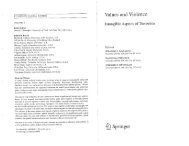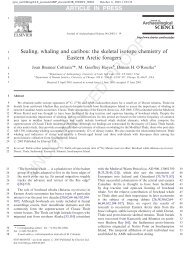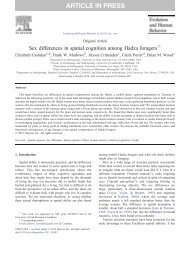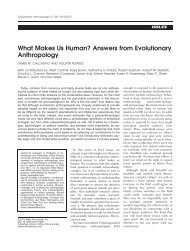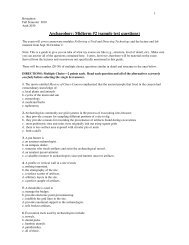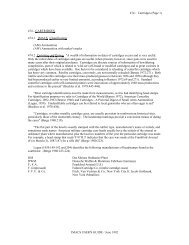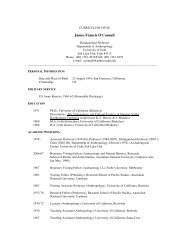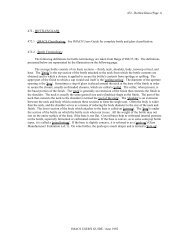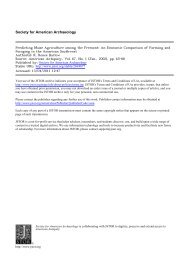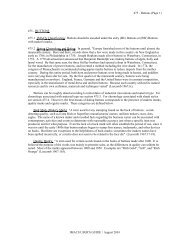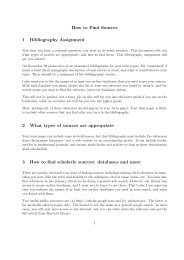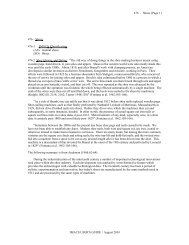Hormones and Competitive Aggression in Women - University of Utah
Hormones and Competitive Aggression in Women - University of Utah
Hormones and Competitive Aggression in Women - University of Utah
Create successful ePaper yourself
Turn your PDF publications into a flip-book with our unique Google optimized e-Paper software.
110 Cashdan<br />
Participants were asked to check as many tactics as they wished for each <strong>in</strong>teraction, <strong>and</strong> to<br />
<strong>in</strong>dicate which tactics were taken by themselves <strong>and</strong> which by their competitors. Only the<br />
former are considered here.<br />
Indirect aggression through social manipulation was not <strong>in</strong>cluded <strong>in</strong> the diary form,<br />
because it was not volunteered by participants <strong>in</strong> the open-ended diaries <strong>and</strong> pretests that led<br />
to its development. This is unfortunate but not surpris<strong>in</strong>g; as Bjo¨rkqvist et al. [1992] note,<br />
such manipulation is socially undesirable <strong>and</strong> hence is unlikely to be admitted or<br />
acknowledged through self-report.<br />
Twelve options were listed for what the competitive <strong>in</strong>teraction was about, <strong>and</strong><br />
participants were told to <strong>in</strong>dicate which option was most appropriate:<br />
1. success at school (gett<strong>in</strong>g better grades than others, etc.)<br />
2. success at work (promotion, recognition, more money)<br />
3. athletic skill (w<strong>in</strong>n<strong>in</strong>g at a sport, etc.)<br />
4. success at another task or activity (please specify)<br />
5. look<strong>in</strong>g attractive<br />
6. the attention <strong>of</strong> a man or men (state their relationship to you)<br />
7. the attention <strong>of</strong> a woman or women (state their relationship to you )<br />
8. popularity<br />
9. prestige/status<br />
10. a physical object, space, or territory (please specify)<br />
11. gett<strong>in</strong>g one’s way (gett<strong>in</strong>g one’s op<strong>in</strong>ion or course <strong>of</strong> action to prevail)<br />
12. other (please specify).<br />
The competition diaries are a method whose advantages <strong>and</strong> disadvantages complement<br />
those <strong>of</strong> more commonly-used approaches. S<strong>in</strong>ce they are not based on directly observed<br />
behavior, they are vulnerable to biases <strong>in</strong> participant awareness, recall, <strong>and</strong> accuracy <strong>in</strong><br />
report<strong>in</strong>g. However, ask<strong>in</strong>g the participant to report on specific recent events should help to<br />
mitigate these biases <strong>and</strong> may make diaries more accurate than questionnaires that ask about<br />
customary behavior. The advantage <strong>of</strong> this method over laboratory studies is that it is able to<br />
tap competitive events that are salient to the <strong>in</strong>dividual, that occur naturally rather than <strong>in</strong><br />
contrived situations, <strong>and</strong> whose outward manifestations may be difficult or impossible to<br />
observe.<br />
Analysis<br />
Because participants differed slightly <strong>in</strong> the number <strong>of</strong> diary entries they completed, I<br />
divided their behavioral scores (for example, the number <strong>of</strong> times they reported us<strong>in</strong>g<br />
aggression) by the number <strong>of</strong> diaries they completed. These numbers were then correlated<br />
with hormone levels.<br />
RESULTS<br />
Although participants were asked to complete ten diaries each, not everyone did so. Four<br />
participants completed fewer than eight diaries, <strong>and</strong> these women were dropped from<br />
the study. The f<strong>in</strong>al sample, therefore, consisted <strong>of</strong> 30 women. Their hormone levels are <strong>in</strong><br />
Table I, <strong>and</strong> correlations between the hormones are <strong>in</strong> Table II. As noted above, I divided<br />
the number <strong>of</strong> times each participant reported a behavior by the number <strong>of</strong> diaries she<br />
completed. The unit <strong>of</strong> analysis, therefore, is the fraction <strong>of</strong> times each competitive behavior



